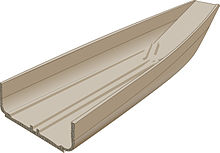Kaffe (ship part)

In traditional inland shipbuilding (barge construction), Kaffe is the name for a design of the end of the hull. This design has been known in northern Germany since the end of the Middle Ages . The etymological origin is unclear. The vehicles built in this way are known as coffee barges . Other names and spellings in historical texts are cap piece , Schaarstück or scarf tip . With the introduction of towage and the machine drive, the coffee is largely the design with Steven vanished. It can only be found in smaller rowing and work vehicles.
Design
The so-called design is characterized by a technologically and geometrically simple principle. The flat bottom of the boat and the sides attached to it at an angle are brought together in a triangular shape towards the end of the fuselage. This is done by bending up or beveling the floor and bending the side walls together. In the extreme case this results in a pointed end of the trunk. This principle has been proven to have been used for at least 3500 years and was also found in the Asian culture area with junks and sampans .
literature
- Michael Sohn: Coffee boats. A bygone form of barge. Self-published by Sohn-Art, Hennigsdorf 2013, ISBN 978-3-00-041659-0 .
- Peter Clark: One step at a time: the Dover Bronze Age boat experimental research program. In: Historical boat and ship replicas. Steffen Verlag, Friedland / Meckl. 2008, ISBN 978-3-940101-25-9 . P. 29.
- Imperial Statistical Office: Traffic on German waterways. Publishing house of the Royal Prussian Statistical Bureau, Berlin 1874.
Web links
Individual evidence
- ↑ Johann Georg Krünitz: Economic-Technological Encyclopedia, or general system of the state-city-house and agriculture, in alphabetical order. Volume 32. 1784. Keywords "Elbkahn" and "Oderkahn"
